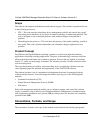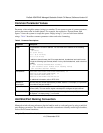
1-1
v1.0, November 2010
Chapter 1
Using the Command-Line Interface
The command-line interface (CLI) is a text-based way to manage and monitor the system. You can
access the CLI by using a direct serial connection or by using a remote logical connection with
telnet or SSH.
This chapter describes the CLI syntax, conventions, and modes. It contains the following sections:
• “Command Syntax” on page 1-1
• “Command Conventions” on page 1-2
• “Common Parameter Values” on page 1-3
• “Unit/Slot/Port Naming Convention” on page 1-3
• “Using the “No” Form of a Command” on page 1-4
• “Managed Switch Modules” on page 1-5
• “Command Modes” on page 1-5
• “Command Completion and Abbreviation” on page 1-9
• “CLI Error Messages” on page 1-9
• “CLI Line-Editing Conventions” on page 1-10
• “Using CLI Help” on page 1-11
• “Accessing the CLI” on page 1-12
Command Syntax
A command is one or more words that might be followed by one or more parameters. Parameters
can be required or optional values.
Some commands, such as show network or clear vlan, do not require parameters. Other
commands, such as network parms, require that you supply a value after the command. You
must type the parameter values in a specific order, and optional parameters follow required
parameters. The following example describes the network parms command syntax:
Format network parms <ipaddr> <netmask> [gateway]


















